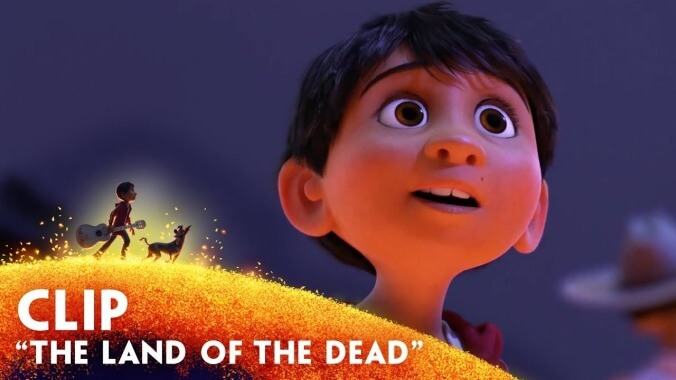Pixar’s world-building was more important than ever in Coco

The thoughtfulness and artistry of a Pixar movie can make for a truly transportive experience, whether the setting is a Parisian bistro, a child’s bedroom, or the depths of the ocean. In almost every case, the world-building provides a solid foundation for even the most fantastical of stories—though the Cars movies may raise more questions about Radiator Springs than they answer.
Immersive world-building is one of the many traditions woven into 2017’s Coco, Lee Unkrich and Adrian Molina’s exquisite tale of remembrance and cultural heritage. Co-written by Molina and Matthew Aldrich (based on a story by Molina, Aldrich, Unkrich, and Jason Katz), Coco is the first major motion picture to boast both an all-Latinx cast—including Gael García Bernal, Edward James Olmos, Alanna Ubach, Renée Victor, and Anthony Gonzalez—and a nine-figure budget. It also happens to be the only Pixar movie to encounter significant criticism before it was released. In 2013, parent company Disney tried to trademark Día De Muertos (or Day Of The Dead), a holiday with roots in Mesoamerican cultures. After a petition opposing the trademark garnered support, Disney dropped the request.
That wasn’t the best way to set about crafting a film steeped in Mexican traditions, certainly not when most of the people involved in the production were white. But Pixar recruited Latinx talent behind the scenes, bringing on prominent political cartoonist Lalo Alcaraz to consult and hiring Camilo Lara of Mexican Institute Of Sound and Mexican American songwriter Germaine Franco to contribute to the score. Franco and Molina also teamed up with Frozen duo Robert Lopez and Kristen Anderson-Lopez, who would write the Oscar-winning “Remember Me.” Daniel Arriaga served as character art director and Alonso Martinez was among Coco’s award-winning animators.
It still wasn’t a given that Coco’s vision would resonate with audiences both familiar with and new to Día De Muertos (or even the Americanized Día De Los Muertos). Jorge R. Gutierrez had already told a somewhat similar story in 2014’s The Book Of Life, which was praised for its animation more than its narrative. (It was also saddled with a framing device that created distance between Mexican culture and the viewer.) But after six years of research trips to Mexico, a marketing misstep, and figuring out how to animate more “fluid” skeletons, Coco premiered to great acclaim at the Morelia International Film Festival, before winning over audiences in the United States and beyond. The result was joyful and ruminative, an exultant fusion of language, history, and music (including son jarocho, mariachi, boleros, and even contemporary Mexican pop). No scene better captures the level of care that went into the movie than the moment that Miguel Rivera (Anthony Gonzalez) first crosses the cempasúchil-covered bridge into the Land Of The Dead.
Like many a Pixar protagonist, Miguel won’t reflexively accept the path laid out for him. He doesn’t want to make shoes like the rest of the pragmatic Rivera family, led by his abuelita Elena (Renée Victor)—he wants to make music like Ernesto de la Cruz (Benjamin Bratt), a dashing crooner whose life was cut short by a giant bell but whose memory lives on in every screening of his films and every performance of “Remember Me.” When Miguel tries to prove to his family that music is a viable career choice, he does some light grave-robbing. Soon, he finds himself crossing over into the land of the ancestors, both his and those of everyone else in Mexico. And the sight that greets him is awe-inspiring, as production designer Harley Jessup combines multiple periods of architecture, from Spanish colonial to Mexican Revolution and Victorian era, with the look of more modern edifices. The city’s layout is incredibly intricate and meaningful—Mesoamerican temples provide the bedrock for later eras and peoples, including mestizos and Chicanos. The saturated colors of homes in Mexico’s hillside districts like Las Palmitas and Guanajuato City and the wrought iron work of Coco’s spiraling city make it at once familiar and fantastical.
And that’s just the gateway into Coco’s riveting story. The Land Of The Dead continues to expand, making room for those who are, like Gael García Bernal’s Hector, caught between the two worlds. Miguel himself isn’t actually cleared for passage—it’s only with the help of the spirits of family members like Mamá Imelda (Alanna Ubach) that he’s able to travel through the city. At its core, Coco is about liminality, about straddling cultures and countries. But each city and world it creates comes fully defined, from the clay-tiled roofs of Santa Cecilia to the Mexican Baroque churches of the spirit world. Tasked with creating an alluring new land and a welcoming homeland, Coco delivered on both.